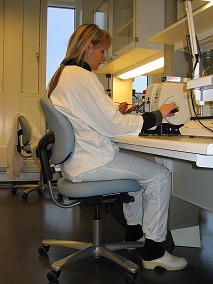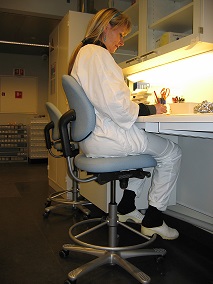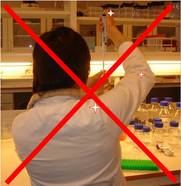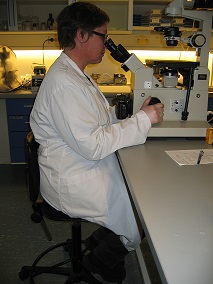Ergonomics in the laboratory - Kunnskapsbasen
Ergonomics in the laboratory
Advice for prevention of muscle and skeleton pain from working in laboratories.
Norsk versjon - Ergonomi i laboratorier
Topic page about HSE | Pages labelled with ergonomics
At NTNU we have several types of laboratories with a wide range of tasks. To prevent work related muscle and skeleton pain, it is important that the workplaces are well accommodated with chairs, workbenches, lights, equipment and machines. Well-functioning logistics in the laboratory, variation in tasks and working positions also contribute to make the workday easier.
Fume hood and safety bench
Working in a fume hood / safety bench can be a challenge for your body. The lack of flexibility in the design of fume hoods / safety benches can provide fixed and unfavourable working positions. Additionally, the work is often unbalanced and repetitive, a combination that can cause a lot of strain on the body over time. Focus on ergonomics while planning the work and while working – the goal is to obtain as good a working position as possible:
- Take out the appropriate equipment and support materials.
- Remove everything you do not need in and under the fume hood /safety bench.
- Consider whether you should work in a standing or seated position / which type of chair to use.
- Make sure the working area is sufficiently lit.
- Avoid static muscle work – make sure to have support for your forehand(s) when possible.
- The nature of the work determines where in the fume hood / safety bench you are working. To ensure sufficient forearm support and adequate ventilation, working approx. 20 cm into the hood is ideal.
- Vary your tasks throughout the day to ensure that your body is not restricted to one working position.
- Take frequent, short breaks.
Laboratory chairs
Laboratory work consists of different types of operations that enables you to use different working positions and motions; standing, walking, sitting, "sit-to-stand". The laboratory chair is an important piece of equipment for adapting your working position and task. It is therefore recommended to keep a selection of different laboratory chairs with different height adjustment options; regular lift for low benches/tables and high lift with a footring for laboratory benches (90 cm). Chairs with a "sit-to-stand" option should also be available.



Familiarise yourself with the chair's adjustment options and variation possibilities:
- Start by adjusting the height of the chair so that your feet rest well on the floor/footring and your knee tendon is at a 90-degree angle minimum. In a "sit-to-stand" chair, the knee angle will be greater – adjust according to the height of the laboratory bench and what feels comfortable and relaxing to your shoulders.
- Adjust the backrest to provide good support for your lower back.
- Adjust the seat depth to support approx. 2/3 of your thighs.
- Use the seat's tilting function actively to vary your sitting position.
Pipetting
Pipetting work is characterised by monotonous and repetitive motions, often with your arms lifted up and away from your body – i.e. static muscle work for your shoulder. The size and grip of the pipette can be unfavourable for your hand. The button pressure can be stressful to your thumb. The work demands good vision, concentration and accuracy.
Think ergonomics to make the work as little stressful as possible:

- Adjust the chair/bench and lighting to the task at hand.
- Select pipettes based on weight, size, grip, button pressure and function.
- Ask your manager about acquiring different types of pipettes if they are not available in your lab.
- Use pipettes with different shapes to vary the strain, especially on your thumb.
- Consider the possibility of automate some of the processes (robot, etc.)
- Find possibilities for angling the stands, and lower the test tubes to allow your arms to stay as low and close to your body as possible.
- Work with your shoulders relaxed and support your elbows/forearms where possible.
- Vary your tasks and take short, frequent breaks.
- Make sure that all equipment is routinely maintained.
Microscopy
Microscopy can be difficult for your body, as your working position is fixed due to your head's position to the eyepiece and operation of the focus adjustment. This type of work requires good vision and concentration.

- If the microscope is placed on a regular table or laboratory bench, it is important that the height is 90 cm to enable as many users as possible to have a good working position. This necessitates a high lift laboratory chair with a footring. Ideally, the microscope should be placed on a table with height adjustment to accommodate individuals of different height. This should be a priority when purchasing new tables.
- Adjustable eyepieces make it easier to use a relaxed working position for your neck. Adjustable eyepieces should be a priority when purchasing new equipment. These can also be used with some older microscopes.
- Find a position with relaxed shoulders and support for the forearm that controls the focus adjustment.
- Take regular breaks and focus on something far away to relieve your eyes.
Lighting
Light is very important when working in a laboratory. General lighting in laboratories requires a minimum of 500 lux. In addition to this, localised lighting above the workbench is required (500–1000 lux).
- Adequate lighting and a balanced distribution of light between the work zone and near zone is important. Too large contrasts can cause fatigue.
- Avoid blinding and reflexes. The work area should be made of a non-reflective material.
- If you are performing laboratory work in dark rooms, you should take frequent breaks in a room with daylight.
- Consider using an illuminated magnifying lamp for work that requires a lot from your vision.
- You should always assess whether the work requires special lighting.
- Some working operations might require lighting of up to 2000 lux.
- The need for proper lighting increases with age. A 60-year-old needs 5–6 times as much light as a 20-year-old.
- During work that requires a correct sense of colour, it is important that colours are naturally and correctly rendered. The colour rendering index (CRI) indicates the percentage of how correct colours are rendered from a light source. A CRI of at least 80 is recommended.
- The ink temperature indicates the luminous colour and is measured in Kelvin (K). Under 3300 K the light is perceived as warm/reddish, between 3300–5300 K the light is white, whereas over 5300 K the light is cold/blue.
- The recommendation in laboratories is to have white light, colour code 840. (The first number indicates colour rendering, 80–89 CRI. The second and third numbers indicate the light source ink temperature, 40 = 4000 K).
- Laboratories often require computer workplaces. These workplaces must be accommodated.
- To ensure good conditions for your vision, it is also important to use glasses when required. Get computer glasses or corrective safety glasses if necessary.
Advice for construction/rehabilitation/purchase of equipment
Creating health promoting workplaces is all about well-accommodated workplaces in terms of ergonomics and environment, which results in high employee well-being. The Working Environment Act details some HSE requirements that have to be followed during construction. A universal design should be emphasised during construction and rehabilitation.
The following aspects are important:
- User partaking: employees, safety representatives, employee representatives. Occupational Health Services and the HSE Division should be included in construction projects as early as possible, participate in fixed meetings and follow up the HSE requirements during the entire construction process.
- Prepare accurate requirement specifications for new equipment/instruments.
- Ergonomics and a universal design should always be a guiding principle: body measurements, height-adjustable equipment, working positions and motions, adequate space, organisation of equipment / room logistics, physical environmental factors (automatic door openers / sliding doors, lighting, noise, indoor climate, flooring), etc.
An example of important ergonomic aspects when preparing a requirement specification for a fume hood and safety bench:
- The application area decides the requirements for access to water, gas and electricity. The placement of the operation handles is essential; they should be placed easily accessible next to the working area. Avoid placement of handles/faucets on the front edge or in the back of the fume hood / bench, as this can cause static working positions.
- The front edge should be as narrow as possible to provide as much space as possible for the legs and body.
- The base must not come in conflict with the leg space. The nature of the work, i.e. the need for equipment, decides the size of the fume hood / bench.
- Fume hoods / benches should not be set up to facilitate two individuals working at the same time. Individual accommodation possibilities must be available.
- Fume hoods / benches with electric height adjustment should be installed on account of different body heights, different tasks, variation possibilities and the requirement of universal design.
- Diagonal front glasses can be important for the viewing distance and angle to achieve good working positions.
- The lower part of the front glass should not have any kind of moulding or strip that would limit vision and could create unfavourable working positions.
- The position of the fume hood / bench in relation to roof lighting is important to avoid bothersome reflexes on the glass surface.
- All types of fume hoods must be equipped with lights from 750 lux to 2000 lux and with shadow-free illumination. The light must be flickerfree (electrical ballast) and equipped with a dimmer. It must be possible to select the correct type of fluorescent tube in relation to the colour rendering. All fume hoods / benches must have easy access to the fluorescent tubes for changing.
- The fume hood / bench must be as quiet as possible. (Sound is measured logarithmically, meaning that a 3 dB difference doubles the sound level.) Noise is stress inducing.
- Forearm support or possibilities for installing support on the fume hood / bench should be available.
- If the forearm support is made of metal, equipping it with a heating element should be considered.
- All fume hoods / benches must be easy to clean in accordance with the department's procedures.
Ergonomic workshop in the laboratory
Assessing the working positions and movements that are used during work in the laboratory can be useful to prevent muscle and skeleton pain. A two-hour workshop in the workplace with colleagues and the occupational physiotherapist can produce new ideas for different ways to conduct the work. Practical problems are solved through discussion and exchange of experiences with the occupational physiotherapist. Could this be useful in your department? Talk to your colleagues and see if they might be interested in this. The recommended group size is 5–8 persons.
The laboratory manager can contact the occupational physiotherapist (in Norwegian) to schedule a workshop.
Other preventive tips
- Prevent work related muscle and skeleton pain
- Heavy and monotonous work
- Customize your computer workplace
- Order safety glasses
- Variation in your workday
Legislation
- The Working Environment Act (in Norwegian)
- The Planning and Building Act (in Norwegian)
- Regulation of organisation, management and partaking (in Norwegian)
- The Workplace Regulation (in Norwegian)
- Regulation of the performance of work (in Norwegian)
Contact
- Tina Hagen, Occupational Physiotherapist
